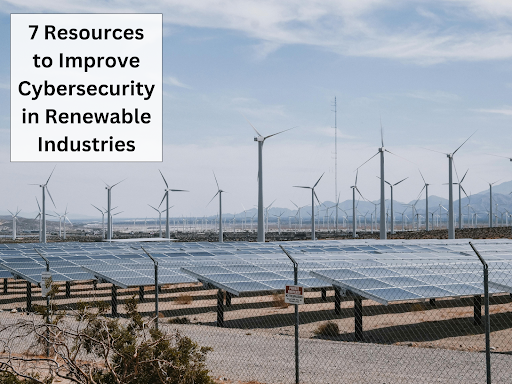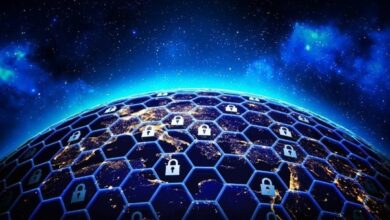7 Resources to Improve Cybersecurity in Renewable Industries

The renewable energy sector’s reliance on digital infrastructure is growing. While developments in IoT-powered energy solutions, automated control systems, and smart grids increase efficiency, they also raise major cybersecurity concerns.
Cybercriminals target renewable sectors first, using weaknesses in operational technology (OT) and industrial control systems (ICS). A single cyberattack without enough protection might compromise essential data, affect energy distribution, or inflict operational and financial losses.
Cyberattacks on renewable energy firms have become more severe recently. Ransomware attacks, illegal access to control networks, and malware infections show the rising demand for strong security systems. Such intrusions seriously compromise national energy security and endanger vital infrastructure. Given the growing frequency of these hazards, companies in the renewable industry have to give cybersecurity plans that protect their assets top priority and guarantee that the continuous electricity supply is of top importance.
Why Renewable Energy Needs Strong Cybersecurity Measures
Since renewable energy systems depend on automation, wind farms, solar plants, and power grids are more efficient and susceptible to cyberattacks. Operating technology (OT) and industrial control systems (ICS) can have security gaps that make them vulnerable to cyberattacks, potentially leading to data breaches, infrastructure failures, or energy disruptions. To better understand these risks and how to address them, a well-structured cybersecurity guide can give useful strategies for identifying weaknesses and strengthening defenses.
Many renewable energy projects operate on outdated systems or unsecured networks, increasing their vulnerability to cyberattacks. Remote monitoring and cloud-based controls further extend the possible attack surfaces. A successful breach can result in financial losses, operational interruptions, and environmental damage. Maintaining grid stability and safeguarding important energy assets depend on robust cybersecurity policies.
7 Essential Resources for Strengthening Cybersecurity in Renewable Industries
1. Cybersecurity Frameworks for Renewable Energy
A disciplined cybersecurity system provides a basis for maintaining infrastructure supporting renewable energy sources. The NIST Cybersecurity Framework provides guidelines for spotting, safeguarding, reacting to, and recovering from cyberattacks.
Similarly, IEC 62443, a widely recognized standard for industrial cybersecurity, outlines security requirements for operational technology (OT) environments. Implementing these frameworks ensures a systematic approach to mitigating risks in renewable energy operations.
2. Threat Intelligence Platforms
Real-time threat intelligence is crucial for identifying and responding to cyber threats before they escalate. MITRE ATT&CK for ICS provides a comprehensive framework detailing the tactics, techniques, and procedures (TTPs) used by cyber attackers targeting industrial control systems, helping organizations anticipate and defend against potential threats.
Additionally, industry-specific threat intelligence platforms aggregate and analyze data on emerging risks, offering actionable insights tailored to the renewable energy sector. By leveraging these tools, firms can proactively enhance their cybersecurity strategies, improve incident response times, and strengthen overall resilience against evolving cyber threats.
3. Industrial Firewalls and Network Segmentation Tools
Firewalls serve as the first line of defense against external threats, blocking unauthorized access to energy infrastructure and monitoring incoming and outgoing network traffic. Next-generation firewalls (NGFWs) offer advanced features such as deep packet inspection and intrusion prevention, further strengthening security.
Network segmentation enhances protection by dividing systems into isolated zones, limiting lateral movement in case of a breach, and preventing attackers from accessing critical assets. Implementing firewalls alongside strict segmentation policies helps renewable energy facilities reduce attack surfaces, contain potential threats, and maintain system integrity.
4. Secure Remote Access Solutions
Remote access to solar facilities, wind farms, and grid control systems introduces cybersecurity risks, as unauthorized access can lead to data breaches or operational disruptions. Implementing virtual private networks (VPNs) ensures encrypted communication between users and systems, preventing data interception.
Additionally, multi-factor authentication (MFA) adds an extra layer of security by requiring multiple forms of verification before granting access. Regular access audits and role-based permissions further minimize vulnerabilities, ensuring that only authorized personnel can interact with critical infrastructure. These measures collectively reduce the risk of cyber incidents and strengthen overall system security.
5. Incident Response and Cybersecurity Training Programs
Cyber threats are constantly evolving, making ongoing staff training essential to maintaining a strong security posture. Regular cybersecurity training programs help employees recognize phishing attempts, social engineering tactics, and other cyber risks that could compromise energy infrastructure.
Online platforms and industry-specific courses provide up-to-date knowledge on emerging threats, best practices, and compliance requirements. Additionally, having a well-structured incident response plan ensures organizations can quickly detect, contain, and recover from cyberattacks, reducing downtime and potential damage.
6. AI-Driven Threat Detection Tools
Artificial intelligence (AI) enhances cybersecurity by continuously monitoring network activity, detecting anomalies, and identifying potential threats in real-time. AI-powered security tools analyze vast amounts of data to recognize patterns, flag unusual behaviors, and predict potential attacks before they occur.
These systems can also automate threat responses, such as isolating compromised devices or blocking malicious traffic, reducing the need for manual intervention. By integrating AI-driven security solutions, renewable energy firms can strengthen their defenses, improve incident response times, and proactively mitigate cyber risks.
7. Compliance and Regulatory Guidelines
Following cybersecurity regulations ensures that firms in the renewable energy sector maintain high standards for infrastructure security. Global frameworks like GDPR (General Data Protection Regulation) focus on data security and privacy, while NERC CIP (North American Electric Reliability Corporation Critical Infrastructure Protection) establishes strict guidelines for protecting critical energy infrastructure from cyber threats.
Compliance with these and other industry-specific regulations strengthens security, helps organizations avoid legal penalties, enhances operational resilience, and reduces cybersecurity risks.
FAQs
What are the biggest cybersecurity threats in renewable industries?
Cyber threats in renewable industries include ransomware attacks, phishing, supply chain vulnerabilities, and industrial control systems (ICS) breaches that can disrupt operations and compromise data.
How can renewable energy companies improve their cybersecurity?
Companies can improve cybersecurity by adopting frameworks like NIST, deploying AI-driven threat detection, securing remote access with MFA and VPNs, and providing regular cybersecurity training for employees.
Why is cybersecurity critical for renewable energy infrastructure?
Cybersecurity protects critical infrastructure from attacks that could cause power outages, financial losses, and operational disruptions, ensuring a stable and secure energy supply.



